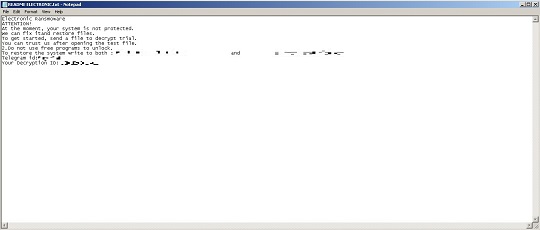Ransom.Win32.BTCAZADI.THLODBC
Ransom:Win32/CylanCrypt.PAC!MTB (MICROSOFT)
Windows


Threat Type: Ransomware
Destructiveness: No
Encrypted:
In the wild: Yes
OVERVIEW
This Ransomware arrives on a system as a file dropped by other malware or as a file downloaded unknowingly by users when visiting malicious sites.
It drops files as ransom note. It avoids encrypting files with the following file extensions.
TECHNICAL DETAILS
Arrival Details
This Ransomware arrives on a system as a file dropped by other malware or as a file downloaded unknowingly by users when visiting malicious sites.
Installation
This Ransomware adds the following processes:
- cmd.exe /c vssadmin.exe delete shadows /all /quiet
- cmd.exe /c ping 127.0.0.1 -n 4 > nul & del \"{Malware File name}\" → if -selfdel is used
It adds the following mutexes to ensure that only one of its copies runs at any one time:
- Global\ELECTRONICMutex
Dropping Routine
This Ransomware drops the following files:
- {Malware File Path}\ELECTRONIC.CPP → Contains log activities
Other Details
This Ransomware does the following:
- Empty Recycled Bin
- By default, it encrypts removable, fixed, and remote drives
- It uses the Windows Restart Manager API to close processes or shut down Windows services that may be keeping a file open and preventing encryption.
It accepts the following parameters:
- -path → Specify the path to encrypt
- -ratio → Encryption ratio
- -nomutex → Execute without generating a mutex
- -nonetdrive → Exclude network drive from encryption
- -selfdel → Delete itself after execution
Ransomware Routine
This Ransomware avoids encrypting files with the following strings in their file name:
- Ntldr
- Ntuser.dat
- Bootsect.bak
- Ntuser.dat.log
- Autorun.inf
- Thumbs.db
- Iconcache.db
- Bootfont.bin
- Boot.ini
- Desktop.ini
- Ntuser.ini
- Bootmgr
- ELECTRONIC.CPP
- README ELECETRONICS.txt
It avoids encrypting files found in the following folders:
- Windows
- $windows.~bt
- $Windows.!ws
- Windows.old
- Windows nt
- All Users
- Public
- Boot
- Intel
- PerfLogs
- System Volume Information
- MSOCache
- $RECYCLE.BIN
- Default
- Config.Msi
- Tor browser
- Microsoft
- Yandex
- Microsoft Visual Studio 16.0
It appends the following extension to the file name of the encrypted files:
- .EMAIL=[{BLOCKED}nicrans@gmail.com ]ID=[{Generated ID}].ELECTRONIC
It drops the following file(s) as ransom note:
- {Encrypted Directory}\README ELECTRONIC.txt

It avoids encrypting files with the following file extensions:
- .sys
- .drv
- .efi
- .msi
- .lnk
- .ELECTRONIC
SOLUTION
Step 1
Trend Micro Predictive Machine Learning detects and blocks malware at the first sign of its existence, before it executes on your system. When enabled, your Trend Micro product detects this malware under the following machine learning name:
-
TROJ.Win32.TRX.XXPE50FFF075
Step 2
Before doing any scans, Windows 7, Windows 8, Windows 8.1, and Windows 10 users must disable System Restore to allow full scanning of their computers.
Step 3
Note that not all files, folders, and registry keys and entries are installed on your computer during this malware's/spyware's/grayware's execution. This may be due to incomplete installation or other operating system conditions. If you do not find the same files/folders/registry information, please proceed to the next step.
Step 4
Search and delete this file
- {Malware File Path}\ELECTRONIC.CPP
Step 5
Scan your computer with your Trend Micro product to delete files detected as Ransom.Win32.BTCAZADI.THLODBC. If the detected files have already been cleaned, deleted, or quarantined by your Trend Micro product, no further step is required. You may opt to simply delete the quarantined files. Please check the following Trend Micro Support pages for more information:
Did this description help? Tell us how we did.

